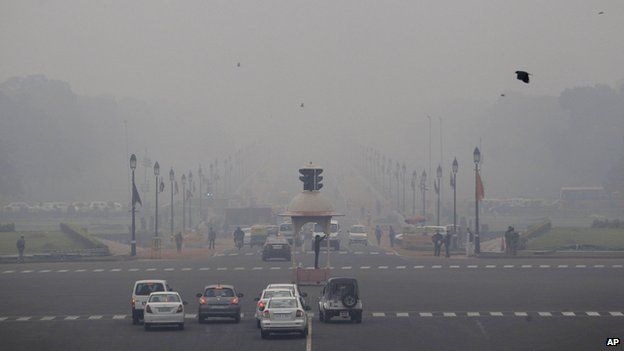Breathing poison in the world's most polluted city
- Published

Saharan dust, traffic fumes and smog from Europe may be clogging up London's air at present - and causing alarm in the newspapers - but in the world's most polluted city London's air would be considered unusually refreshing. That city is Delhi, the Indian capital, where air quality reports now make essential reading for anxious residents.
In London last week, the most dangerous particles - PM 2.5 - hit a high of 57 - that's nearly six times recommended limits.
Here in Delhi, we can only dream of such clean air.
Our reading for these minute, carcinogenic particles, which penetrate the lungs, entering straight into the blood stream - is a staggering 215 - 21 times recommended limits. And that's better than it's been all winter.
Until a few weeks ago, PM 2.5 levels rarely dipped below 300, which some here have described as an "air-pocalypse".
Like the rest of the world, those of us in Delhi believed for years that Beijing was the world's most polluted city.
But last May, the World Health Organization announced that our own air is nearly twice as toxic.
The result, we're told, is permanent lung damage, and 1.3 million deaths annually. That makes air pollution, after heart disease, India's second biggest killer.
And yet, it's only in the past two months as India's newspapers and television stations have begun to report the situation in detail that we've been gripped, like many others, with a sense of acute panic.
It's a little bit like being told you're living next to an active volcano that might erupt at any moment.
At first, we simply shut all our doors and windows and sealed up numerous gaps. No more seductively cool Delhi breezes could be allowed in.
We began checking the air quality index obsessively.
Then, we rushed out to buy pollution masks, riding around in our car looking like highway robbers. But our three-year-old wouldn't allow one anywhere near her face.
Our son only wore his for a day, and only because I told him he looked like Spider-Man.
Despite our alarm, many Delhi-ites reacted with disdain. "It's just dust from the desert," some insisted. "Nothing a little homeopathy can't solve," others said.
But we weren't convinced.
When we heard that certain potted plants improve indoor air quality, we rushed to the nursery to snap up areca palms, and a rather ugly, spiky plant with the unappealing moniker, mother-in-law's tongue.
But on arrival, the bemused proprietor informed us that the American embassy had already purchased every last one.
In any case, we calculated that to make a difference, we needed a minimum of 50 plants.
"We could get rid of the sofa to make room for them," my husband offered.
Instead, we borrowed an air pollution probe from a friend to work out what progress, if any, we'd made.
Switching it on, our P-M 2.5 levels registered an off-the-charts 44,000.
My husband scratched his head, consulting the manual.
"This says 3,000 is hazardous."
"It must be broken," I said.
But it wasn't, so we had to call in the experts.
One afternoon, a young man turned up with a small, free-standing air filter, specially modified for Delhi's dust. He pressed a button, which activated something called a "plasma cluster".
After 20 minutes, the numbers on our air monitor began to drop... precipitously.
My husband and I watched, mouth agape, as the readings went down from 44,000, to 20,000, then 11,000. Eventually, the probe settled around the 1,000 mark.
That's still worryingly high by global standards... and that's only the air inside our home. There's nothing we can do about the air outside.
The government has announced that it will install more air quality monitors in Delhi and that it will ban diesel-belching vehicles more than a decade old.
But that's a drop in the ocean compared to India's pro-growth economic policies, which still rely heavily on subsidised, dirty diesel.
The trouble is on many days, you can't see the pollution.
Right now outside my window is an intensely blue sky filled with flocks of lime green parakeets and frangipani trees just beginning to unfurl their waxy, fragrant blossoms and I find myself wondering if it isn't perfectly OK to take my kids out to play football.
But in the past few months, at least a dozen families we know have moved away, either to cleaner towns and cities, or outside of India.
And although I'm still lulled by the reassurances of long-time residents - "Don't worry - it's nothing," they chide - I am beginning to wonder if it isn't time to think about moving too.
Compared to Delhi right now, London and even Beijing are looking like pretty good options.
How to listen to From Our Own Correspondent:
BBC Radio 4: Saturdays at 11:30 BST
BBC World Service: At weekends - see World Service programme schedule or listen online.
Subscribe to the BBC News Magazine's email newsletter to get articles sent to your inbox.